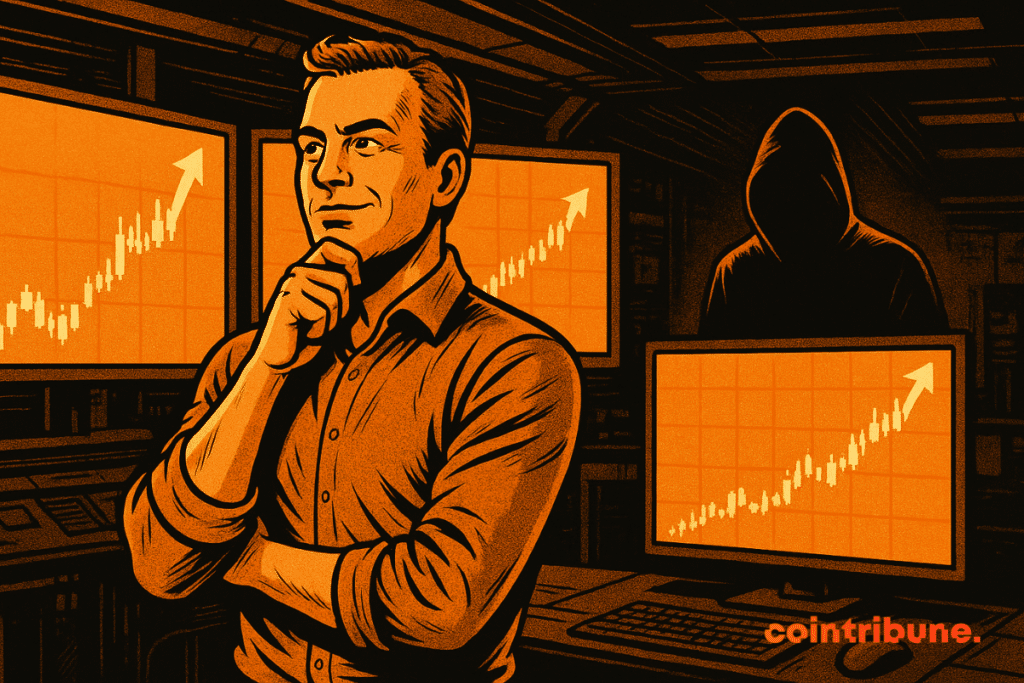Crypto Fraud Alert : Token Cloning Techniques Exposed
As the crypto market regains strength, a silent threat resurfaces. Binance, one of the leading exchange platforms, warns about the resurgence of scams related to fake tokens. Imitating legitimate projects, these scams are trapping more and more investors, sometimes experienced ones. In a context of euphoria and massive capital return, this drift calls into question the security of exchanges.

In Brief
- Binance warns about a worrying upswing in scams related to fake tokens in the crypto ecosystem.
- Scammers imitate popular tokens by copying names, logos, and codes to deceive investors.
- Several forms of fraud have been identified: trapped airdrops, fake websites, fictitious partnerships, etc.
- Binance recommends always verifying a token’s contract address through official sources.
Fake Tokens : A Threat Identified by Binance
In a message posted on the social network X (formerly Twitter) on May 1, 2025, Binance issued a warning to the crypto community regarding the resurgence of scams based on the creation of fake tokens.
The message is explicit :
Scams involving fake tokens are on the rise. Fraudsters create fake crypto assets to imitate legitimate assets, then use them to steal funds or data. Stay vigilant. Always be vigilant.
Binance here warns about a growing practice that involves creating fake cryptos by copying the name, visual identity, and even the code of existing tokens. The objective is clear: to deceive investors, recover their funds, or even their personal data.
This warning echoes others issued by specialized actors, such as the X account “Susbarium,” focused on security in the Shiba Inu ecosystem, which denounces opportunistic attacks falsely claiming affiliation with the SHIB community: “some groups attempt to exploit the Shiba Inu ecosystem by launching unofficial tokens while making false claims of affiliation with SHIB.”
Such a phenomenon, made possible by the openness of public blockchains, is all the more worrying because it targets all types of users. DEX platforms (decentralized exchanges), where any token can be listed without prior control, offer fertile ground for this type of fraud. Specifically, fake tokens can take various forms:
- Imitating the name of a popular token with just one letter changed ;
- Copying the logo and branding of an existing project to create visual confusion ;
- Creating fake official websites that replicate the interface and graphic style of a recognized protocol ;
- Distributing tokens via airdrops accompanied by fraudulent promotional messages ;
- False promises of partnership or integration with famous ecosystems like Shiba Inu or popular Layer 2 solutions.
These practices aim to abuse the trust generated by a project’s reputation and can prove to be alarmingly effective, especially with inexperienced or less vigilant users.
Binance’s Concrete Recommendations
Faced with this critical situation, Binance also provided a set of technical recommendations for its users. In its post, the exchange emphasizes the importance of systematically verifying a token’s contract address, the only unalterable information that allows authenticating a crypto asset.
Binance specifies that “each digital token has an associated contract address” and reminds that this address should always be checked on official sources such as the project’s website or platforms like CoinGecko and CoinMarketCap.
Additionally, Binance highlights the use of risk analysis tools that can detect technical anomalies: suspicious contract code, locked liquidity, abnormally low volume, or even nonexistent market capitalization.
However, using these tools, such as token scanners, remains challenging for non-technical users. For this reason, the exchange encourages users to stay informed, follow market trends, and strengthen their education on blockchain mechanisms. It is also advised to monitor a token’s metrics: a legitimate asset should show consistency between its price, liquidity, and number of holders.
These practical tips are part of a broader strategy aimed at limiting the impact of these scams on investor confidence. While the crypto ecosystem has always attracted fraud attempts during bullish periods, the growing sophistication of the techniques used demands a collective response, combining regulation, project transparency, and user accountability. In a still young and partially decentralized sector, protection primarily relies on education and vigilance. Will the community be able to mobilize in time against this silent but fearsomely effective scourge?
Maximize your Cointribune experience with our "Read to Earn" program! For every article you read, earn points and access exclusive rewards. Sign up now and start earning benefits.
Diplômé de Sciences Po Toulouse et titulaire d'une certification consultant blockchain délivrée par Alyra, j'ai rejoint l'aventure Cointribune en 2019. Convaincu du potentiel de la blockchain pour transformer de nombreux secteurs de l'économie, j'ai pris l'engagement de sensibiliser et d'informer le grand public sur cet écosystème en constante évolution. Mon objectif est de permettre à chacun de mieux comprendre la blockchain et de saisir les opportunités qu'elle offre. Je m'efforce chaque jour de fournir une analyse objective de l'actualité, de décrypter les tendances du marché, de relayer les dernières innovations technologiques et de mettre en perspective les enjeux économiques et sociétaux de cette révolution en marche.
The views, thoughts, and opinions expressed in this article belong solely to the author, and should not be taken as investment advice. Do your own research before taking any investment decisions.